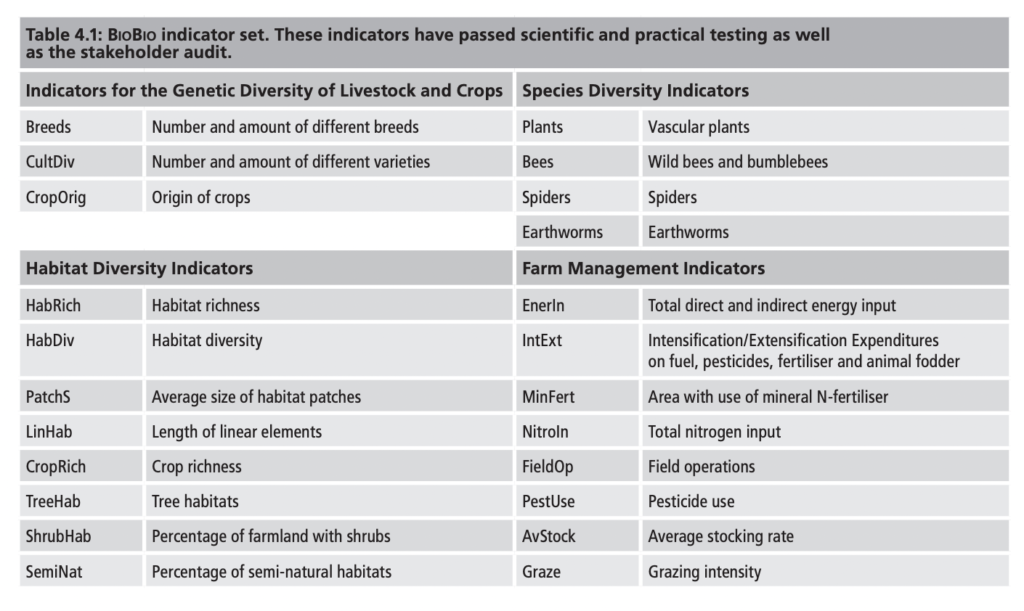Many definitions of regenerative agriculture point to three main environmental outcomes: increased biodiversity, improved soil health, and soil carbon sequestration. Of these three outcomes biodiversity can be one of the more difficult ones to measure since accurately depicting trends in biodiversity can require measurements over large spatial areas and over long time periods. Some of the studies on regenerative systems I have read have conducted measurements meant to be indicative of biodiversity such as invertebrate species richness, predator species abundance, earthworm abundance, soil microbial biomass, total bacterial biomass, and reports from farmers visual assessments on the presence of ladybugs and earthworms (Fenster, LaCanne, et al., 2021; Fenster, Oikawa, et al., 2021; Luján Soto et al., 2021; Pecenka & Lundgren, 2019). Measuring trends in biodiversity, however, is no simple task. One of the most frequently used measurements for capturing biodiversity information is species richness–however, this metric is problematic given that species richness is highly scale-dependent and that species richness can be affected by other factors (such as species abundance and distribution for example) meaning that simply finding a change in richness provides little information about what else may be at play (Hillebrand et al., 2018). In the framework put forth by Hillebrand et al. (2018) measurements of species turnover and a focus on long-term consistency may be key to getting a more accurate picture of changes in biodiversity. This of course poses some research challenges as more complex and intensive biodiversity monitoring requires more time and money.
Given the challenges with accurately assessing changes in biodiversity, it would seem more prudent perhaps to use a different tool or framework that provides a snapshot of information about the state of biodiversity at the farm-level, as opposed to taking limited biodiversity measurements that could perhaps provide an inaccurate depiction of certain trends. The Agroscope Research Station in Switzerland came up with a list of 23 indicators of farmland biodiversity as a part of the Biobio research project (Herzog et al., 2012).

These indicators were developed with the aim of detecting trends in biodiversity on farmland throughout Europe, in a way that is scientifically sound, useful for stakeholders, and can be accurately and affordably measured (i.e. doesn’t require too many different indicators). As shown in the diagram from the guidebook from Agroscope, the indicators relate to habitat, species, and genetic diversity as well as farm management factors. The farm management indicators that pertain to energy use, external inputs, field operations (mowing and plowing), and livestock operations are indirect indicators of biodiversity, but are all factors that are highly correlated with habitat structure and species diversity (Herzog et al., 2012). This framework of course does not negate the need for broader off-farm biodiversity monitoring as well, but it is an important tool for understanding the role agriculture plays in biodiversity trends.
Perhaps rather than measuring various things like the species richness and abundance of arthropod communities, something like the Biobio indicators could be used as a checklist of sorts to provide a wider and more accurate view of diversity on regenerative farms. Rather than knowing there are 5 different species of beetles, for instance, more could be gleaned by assessing crop/livestock genetic diversity, the state of habitat and species diversity on the farm, and what management practices are in place that could be impacting diversity outcomes. This information could not only provide valuable information about the state of farm biodiversity but could also give insight into what areas on the farm could be improved upon. Given the fact that agriculture accounts for 40% of global land area and is the leading cause of terrestrial biodiversity loss (UNCCD, 2022), more detailed learning, not just about the state of farmland biodiversity, but which aspects of farming may be benefitting or harming biodiversity is key.
References
Fenster, T. L., LaCanne, C. E., Pecenka, J. R., Schmid, R. B., Bredeson, M. M., Busenitz, K. M., Michels, A. M., Welch, K. D., & Lundgren, J. G. (2021). Defining and validating regenerative farm systems using a composite of ranked agricultural practices. F1000Research, 10.
Fenster, T. L., Oikawa, P. Y., & Lundgren, J. G. (2021). Regenerative Almond Production Systems Improve Soil Health, Biodiversity, and Profit. Frontiers in Sustainable Food Systems, 256.
Herzog, F., Balázs, K., Dennis, P., Friedel, J., Geijzendorffer, I. R., Jeanneret, P., Kainz, M., & Pointereau, P. (2012). Biodiversity Indicators for European Farming Systems A Guidebook.
Hillebrand, H., Blasius, B., Borer, E. T., Chase, J. M., Downing, J. A., Eriksson, B. K., Filstrup, C. T., Harpole, W. S., Hodapp, D., Larsen, S., Lewandowska, A. M., Seabloom, E. W., Van de Waal, D. B., & Ryabov, A. B. (2018). Biodiversity change is uncoupled from species richness trends: Consequences for conservation and monitoring. Journal of Applied Ecology, 55(1), 169-184. https://doi.org/https://doi.org/10.1111/1365-2664.12959
Luján Soto, R., de Vente, J., & Cuéllar Padilla, M. (2021). Learning from farmers’ experiences with participatory monitoring and evaluation of regenerative agriculture based on visual soil assessment. Journal of Rural Studies, 88, 192-204. https://doi.org/https://doi.org/10.1016/j.jrurstud.2021.10.017
Pecenka, J. R., & Lundgren, J. G. (2019). Effects of herd management and the use of ivermectin on dung arthropod communities in grasslands. Basic and Applied Ecology, 40, 19-29.
UNCCD. (2022). Summary for Decision Makers (Global Land Outlook, second edition, Issue.